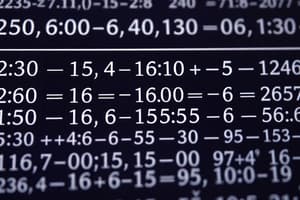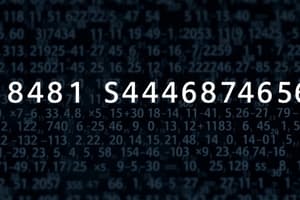Podcast
Questions and Answers
What is the common difference in the sequence 10, 7, 4, 1?
What is the common difference in the sequence 10, 7, 4, 1?
- 3
- -3 (correct)
- 7
- 10
How can you verify if a sequence is arithmetic?
How can you verify if a sequence is arithmetic?
- Ensure the difference between consecutive terms is constant (correct)
- Verify if the difference between any two non-consecutive terms is constant
- Examine if all terms are positive integers
- Check if the first term is greater than the last term
In an arithmetic sequence, if the first term is 5 and the common difference is 4, what is the fifth term?
In an arithmetic sequence, if the first term is 5 and the common difference is 4, what is the fifth term?
- 21 (correct)
- 18
- 25
- 33
What is the formula to find the sum of the first n terms of an arithmetic sequence?
What is the formula to find the sum of the first n terms of an arithmetic sequence?
Which of the following is true about the graph of an arithmetic sequence?
Which of the following is true about the graph of an arithmetic sequence?
Flashcards are hidden until you start studying
Study Notes
Arithmetic Sequence
-
Definition: An arithmetic sequence is a sequence of numbers in which the difference between consecutive terms is constant.
-
Common Difference (d):
- The constant difference between consecutive terms.
- Calculated as ( d = a_{n} - a_{n-1} ).
-
General Form:
- The n-th term of an arithmetic sequence can be expressed as: [ a_n = a_1 + (n-1) \cdot d ]
- Where:
- ( a_n ) = n-th term
- ( a_1 ) = first term
- ( n ) = term number
- ( d ) = common difference
-
Examples:
- Sequence: 2, 5, 8, 11, ...
- Here, ( a_1 = 2 ) and ( d = 3 ).
- Sequence: 10, 7, 4, 1, ...
- Here, ( a_1 = 10 ) and ( d = -3 ).
- Sequence: 2, 5, 8, 11, ...
-
Sum of an Arithmetic Sequence:
- The sum ( S_n ) of the first n terms can be calculated using: [ S_n = \frac{n}{2} \cdot (a_1 + a_n) ]
- Alternatively: [ S_n = \frac{n}{2} \cdot (2a_1 + (n-1)d) ]
-
Key Properties:
- Arithmetic sequences can be finite (with a limited number of terms) or infinite (continuing indefinitely).
- The graph of an arithmetic sequence is a straight line.
-
Applications:
- Used in various fields such as finance (e.g., calculating linear interest), computer science (e.g., algorithm analysis), and everyday problems (e.g., budgeting).
-
Identifying an Arithmetic Sequence:
- Check if the difference between consecutive terms is constant.
Important Notes
- Always verify the common difference to confirm the sequence is arithmetic.
- The first term and common difference are crucial for defining the sequence's behavior.
Arithmetic Sequence
- An arithmetic sequence features a constant difference between consecutive terms, known as the common difference (d).
- The common difference can be computed by subtracting the previous term from the current term, represented as ( d = a_{n} - a_{n-1} ).
General Form
- The n-th term of an arithmetic sequence is determined by:
[
a_n = a_1 + (n-1) \cdot d
]
where:
- ( a_n ) = n-th term
- ( a_1 ) = first term
- ( n ) = term number
- ( d ) = common difference
Examples
- Example Sequence: 2, 5, 8, 11...
- Initial term (( a_1 )) is 2
- Common difference (( d )) is 3
- Another Example: 10, 7, 4, 1...
- Initial term (( a_1 )) is 10
- Common difference (( d )) is -3
Sum of an Arithmetic Sequence
- The sum (( S_n )) of the first n terms can be calculated by: [ S_n = \frac{n}{2} \cdot (a_1 + a_n) ]
- An alternative formula for the sum is: [ S_n = \frac{n}{2} \cdot (2a_1 + (n-1)d) ]
Key Properties
- Arithmetic sequences can be either finite, containing a specific number of terms, or infinite, continuing indefinitely.
- The graphical representation of an arithmetic sequence appears as a straight line, illustrating the linear growth or decline.
Applications
- Commonly utilized in finance for calculating linear interest and in computer science for algorithm analysis.
- Practical in everyday scenarios, such as budgeting and financial planning.
Identifying an Arithmetic Sequence
- Confirm an arithmetic sequence by checking if the difference between consecutive terms remains constant.
- The first term and the common difference are essential for determining the sequence's characteristics and behavior.
Studying That Suits You
Use AI to generate personalized quizzes and flashcards to suit your learning preferences.




